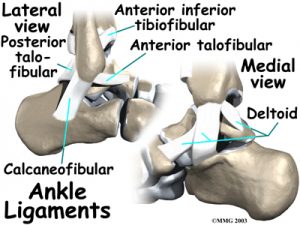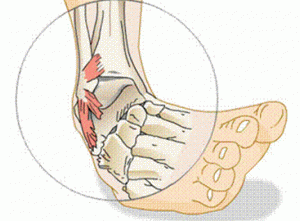
Ankle Sprain and Instability
Ankle Sprain and Instability
Ankle ligament problems – sprains and instability
FAQs
- What are the ligaments of the ankle?
- How do they get injured?
- What should I do if I sprain my ankle?
- When should I go to casualty?
- Should I have physiotherapy?
- Will I keep having trouble with my ankle?
- How would ankle instability be diagnosed?
- What can be done about ankle instability?
- Will I need an operation?
- I sprained my ankle three months ago?
- I sprained my ankle last year?
What are the ligaments of the ankle?
The ankle joint is a hinge between the leg and the foot. The bones of the leg (tibia and fibula) form a sort of slot and the curved top bone of the foot (talus) fits between them. The talus is held to the tibia and fibula by strong bands of tissue called ligaments. Each ligament is made of many strands or fibres of a material called collagen, which is extremely strong.

The ligament on the inside of the ankle (medial or deltoid ligament) has two layers; the deepest one is most important. This ligament is mainly torn in association with severe fractures of the ankle bones.
The ligament on the outside of the ankle (lateral ligament) is made up of three separate bands: one at the front (anterior talo-fibular ligament), one in the middle (calcaneo-fibular ligament) and one at the back (posterior talo-fibular ligament). The front band is the usual ligament injured in sprains or tears of the ankle ligaments, and the middle band is sometimes affected.
The tibia and fibula have a small joint between themselves just above the ankle. This also has strong ligaments, one at the front and one at the back. (tibio-fibular ligaments). The ligament at the front is involved in 10-20% of ankle sprains; the ligament at the back, like the deltoid ligament, is mainly damaged in association with severe fractures of the ankle bones.
How do they get injured?
Most ankle ligament injuries are caused when the foot twists so that the sole is pointing inwards (inversion), usually when the foot is pointing downwards rather than flat on the ground. When this happens, the full force of the body’s movement is placed on the anterior talo-fibular ligament. This may stretch, with tearing of some of its fibres (sprain) or it may tear completely. If there is a major injury of the anterior talo-fibular ligament, the forces transfer to the calcaneo-fibular ligament and the tibio-fibular ligaments, which may also be sprained or torn. Occasionally small pieces of bone may be torn off with the ligaments.

In a few cases, a twisting force on the ankle may cause other damage. The bones around the ankle may be broken, a piece of the joint surface inside the ankle may be chipped off, ligaments connecting other bones in the foot may be sprained or torn, or the tendons around the ankle may be damaged.
What should I do if I sprain my ankle?
Most ankle sprains are fairly minor injuries which will get better with simple self-care treatment. For a south Indian it is easy to remember the word RICE which forms the basic treatment of a sprained joint:
- Rest take the weight off the injured joint as much as possible for a day or two
- Ice an ice pack (a small bag of frozen peas or corn is ideal) can be applied for 10-15 minutes 3-4 times a day to reduce swelling
- Compression a firm bandage or strapping will help to get swelling down
- Elevation resting with the ankle above the height of the body will allow swelling to drain away into the bloodstream
Although a couple of days rest is useful, it is best to start taking some weight on the injured ankle reasonably soon after injury, usually within 2-3 days. Also start to exercise and stretch the injured ankle as soon as possible after the injury.
Normally a sprained ankle will recover within 6-8 weeks, although it may tend to swell for a few weeks longer.
When should I go to Hospital?
Basically, if you have a severe ankle injury it is best to get professional advice immediately. Things that suggest a severe injury include:
- your ankle is so painful you cannot bear any weight on it
- the ankle seems deformed
- the skin over the ankle is broken
- the injury was caused by a severe force such as a fall from a height or a blow from a heavy object
- the pain and swelling seem to get worse rather than better over the first 3-4 days (the bruising often gets worse for a week or more before it starts to fade)
Will I keep having trouble with my ankle?
Most ankle injuries get better completely and cause no long-term problems. Sometimes, however, there is some permanent damage to the ankle. The ligaments may fail to heal properly and become weak, or there may be damage to the joint itself or some other structure nearby.
Most importantly, an ankle ligament injury also damages the small nerve endings in the joint and ligaments. These endings are very important, as they tell your brain where your ankle is and what position it is in (they are called “proprioceptive nerves”). Your brain relies on this information to control the muscles which move and protect your ankle. If these nerve endings are not working properly, your brain does not get reliable information and the muscles around your ankle may not work together properly. You would feel this as a tendency for your ankle to “give way”, often with minor stresses. This might make you prone to repeated ankle sprains. This is referred to as “ankle instability” and is more commonly due to damage to the proprioceptive nerves than actual weakness of the ligaments.
How would ankle instability be diagnosed?
Foot and Ankle Surgeon should examine you and he/she will try to see if there is anything, which makes you more liable to ankle instability than average. They will look for any sign that you have some other problem around your ankle, such as damage to the joint surface. They will stretch your ankle in various directions to see if the ligaments are abnormally weak.
An Xray will usually be taken to see if there is any damage to the bones of your ankle. Ligaments do not show on Xrays. Ligament damage can be shown by taking Xrays with your ankle stretched in various directions (“stress views”), by injecting dye into your ankle or around a neighbouring tendon, or with a magnetic (MRI) scan. However, these special tests are usually not needed at first.
What can be done about ankle instability?
As most people with ankle instability have proprioceptive nerves which are not working properly, the first treatment is a physiotherapy programme to re-train these nerves how to respond to movements of the ankle, by doing various exercises and activities. If your ankle or Achilles tendon are stiff, you will also be shown exercises to stretch these, and the strength of the muscles around the ankle will be increased by exercises. If your foot shape makes you prone to extra stress on the ankle ligaments, a moulded insole may be advised for your shoe to reduce these stresses.
Many people will find their ankle much more stable and comfortable after physiotherapy. However, in some people problems continue. At this point the opinion of an orthopaedic foot and ankle surgeon would be helpful. If you have not already had the special tests mentioned above, these may be done now. The surgeon may also suggest an exploratory operation on your ankle (arthroscopy) to check on the state of the joint. If these tests suggest weakness of the ankle ligaments, an operation may be advised.
Will I need an operation?
Most people with ankle instability will not need an operation. Even if your ankle still feels unstable after physiotherapy, you could try a brace rather than having an operation to tighten up or replace the ligaments.
However, if no other treatment makes your ankle comfortable and tests show that the ligaments are weak, an operation may help. There are two main types of operation:
the damaged ligaments are tightened up and re-attached to the bone – often known as the Brostrum procedure. This is suitable when the instability is not too severe. Its main advantage is that it causes less stiffness than the other type of repair, as it aims to achieve an anatomical repair of the ligaments.
another piece of tissue, usually part of one of the nearby tendons, is borrowed and stitched between the bones where the ligaments should be. This is suitable when the instability is severe or you may put severe stresses on the repair. It is very strong but often causes quite a lot of stiffness in the ankle afterwards.
You would usually be in a plaster or brace for several weeks after an operation and would need further physiotherapy to help regain normal function.
The other problems which may occur after a ligament reconstruction operation include: pain in the ankle, either because of damage at the time of the original injury or because the ankle is now tighter than before
numbness or tingling down the side of the foot due to stretching of one of the nerves either at the time of the original injury or the operation
persistent swelling of the ankle
I sprained my ankle three months ago but it’s still painful and swollen. Why?
Your ankle may be just taking longer than usual to recover. However, there may be some other damage to the ankle if it is still causing trouble three months after injury. It would be worth consulting your GP or physiotherapist.
I sprained my ankle last year. It’s fine now – can I prevent it happening again?
You can’t absolutely prevent another injury, but there are things you can do to reduce the risk. Obviously, take care when walking to avoid catching your foot on uneven bits of pavement (especially when you are in a hurry or have had a few drinks). High-heeled shoes put extra stress on your ankle and should be avoided. If your ankle or Achilles tendon are stiff this puts extra stress on your ankle ligaments when you walk or run, and exercises would probably improve this.
If you play sport, you should take extra care to warm up and down properly, with plenty of stretches to your ankle and Achilles tendon. Strapping your ankle or wearing a sports ankle support may reduce the risk of another injury but this has not been conclusively proven. If your injury was a bad one, it would be worth asking a physiotherapist about a re-training programme for the proprioceptive nerves in your ankle. Your GP or sports club could arrange this.
ALSO READ


How To Choose The Ideal Paper Writing Service
Posted On 24 May 2023
When you use a paper writing service, then you are picking a company that's devoted to your needs. They are…
APA Live Chat – The Way I Could Write My Paper?
Posted On 8 May 2023
If you've got a big test coming up and you need to have it done on time, and then you…
How to Write My Paper Cheaply
Posted On 7 May 2023
There are many ways to compose my paper inexpensively. In fact, some approaches can actually save money for the writer.…
Posted On 4 May 2023
Have Fun and Enjoy a Fun Way to Enjoy your time at home by playing free slots at the casino…
How to Write My Essay About Writing Sample Papers
Posted On 23 Apr 2023
Are you worried about how to write my own article? I understand, it's somewhat intimidating when you first begin learning…

College Application Essay Writing Service Voucher Reddit.com
Posted On 12 Apr 2023
This will suggest having a apparent being familiar with of the supply material or the subject and sticking shut to…

Quality Custom Essay Writing Service Reddit.com
Posted On 12 Apr 2023
Many universities present distinctive deals with savings which you could uncover fascinating. This way you will hardly ever free the…
Reddit Custom Essay Writing Service For Cheap
Posted On 12 Apr 2023
The Looming Questions: Will the reserve be a accomplishment or not? How considerably would this maximize your composing money? Now,…
Reddit Essay Writing Service Atlanta Ga
Posted On 11 Apr 2023
Pretty much as vital as firm any time you are producing essays, is concept generation. Nothing at all will kill…
Reddit.com Persuasive Essay Writing Service Online
Posted On 11 Apr 2023
As aspect of the organizing for faculty admissions, a timeline ought to be established in progress. Consequently, your site visitors…